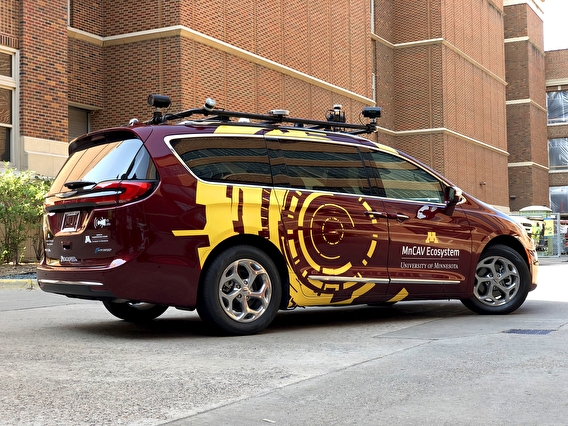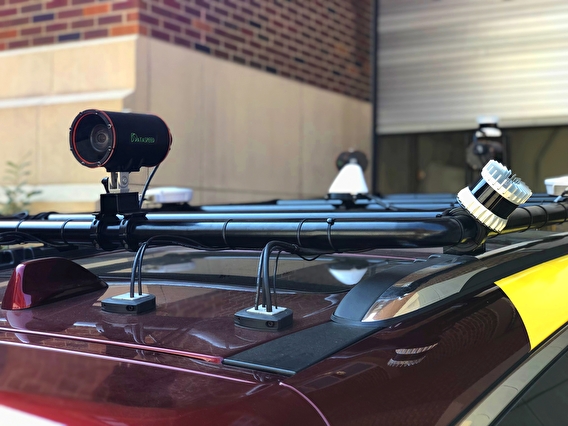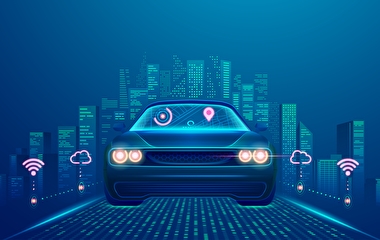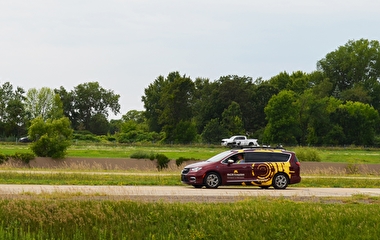
With the arrival of its fully outfitted autonomous vehicle in July, the University’s MnCAV Ecosystem is ready to facilitate research and testing of sensing technologies, vehicle control, platooning, traffic patterns, and other topics related to connected and autonomous vehicles (CAVs).
This centerpiece of the MnCAV Ecosystem’s research facilities is a 2021 Chrysler Pacifica Hybrid minivan that will serve as a customizable, experimental testbed. Program partner Dataspeed Inc. installed a suite of sensors to allow the vehicle to “see” the world surrounding it, detecting objects and pedestrians and tracking their motion over time. Three lidar units, four cameras, and two GPS antennas are affixed to the vehicle’s roof rack, while radar units are integrated into the front and rear bumpers. In addition, the car will carry a dedicated short-range communications (DSRC) on-board unit, allowing for vehicle-to-vehicle and vehicle-to-infrastructure connectivity.
Under the hood, the vehicle’s technologies include computing hardware and Dataspeed’s custom self-driving software. Programmed algorithms send electronic signals to the drive-by-wire kit, which allows seamless electronic control of the vehicle’s braking, throttle, steering, and shifting.
As currently instrumented, the vehicle is capable of level 2 automation, based on SAE International’s six levels of vehicle automation. (A driver can, however, override the automation at any time.) Specific capabilities include camera-based lane-keeping assist, radar-based adaptive cruise control, camera-based lane detection, lidar-based object detection, map-based lane keeping, and DSRC connectivity. As a result, the vehicle can appropriately change lanes, center in a lane, and adapt its speed to a vehicle in front of it. Pressing a button on the steering wheel engages the AV functionality, enabling the vehicle to read lane markings and determine the best position within the lane. When the turn signal is used, the vehicle senses for surrounding vehicles and the type of lane marking to determine if it’s appropriate to switch lanes.

Vehicle manager Brian Davis, a research fellow in the Department of Mechanical Engineering, says the platform will enable researchers to “test connectivity and automation in vehicles that are like ‘real’ vehicles—driving at freeway speeds, for example, and other typical driving situations.” Some specific applications may include testing methodologies and how automation interacts with human drivers. “Any topic you can think of, we’ll be able to test with this vehicle. It gives researchers a complete, fully realized platform to plug their piece into,” he says.
Mechanical engineering professor Rajesh Rajamani will be one of the first researchers to use the new autonomous vehicle in a project co-funded by the Minnesota Local Road Research Board and the Minnesota Department of Transportation. His project will test the capabilities and performance limitations of the new vehicle as well as study the changes such vehicles may require to the winter road maintenance and work-zone guidelines of transportation agencies in Minnesota.
CTS Associate Director of Engagement and Education Gina Baas, who serves as MnCAV’s program director, notes the unique benefits the vehicle will provide researchers. "This research vehicle gives the University flexibility to change and adapt as AV technology evolves,” she says. “It’s an important tool for University researchers to advance their work and contribute to the deployment of these technologies in Minnesota.”
The MnCAV Ecosystem will draw on its unique strengths to conduct research in the areas of cold weather conditions, equity, public perception and trust, the connected environment, and vulnerable road users.

The MnCAV Ecosystem was established by CTS in 2020 with funding from 13 partners, including a major contribution from the U’s Office of the Vice President for Research. The program brings together interdisciplinary researchers, government, and industry partners to create and test CAV technologies under real-world operating conditions.
One such partner is Minnesota-based VSI Labs, who will work with the MnCAV Ecosystem to develop instructional material for researchers and students to better understand the building blocks of CAV systems. VSI will also develop software and provide access to its own automated vehicle to facilitate research and demonstrations focused on vehicle platooning, which requires two fully automated vehicles.
“VSI Labs is delighted to support the University’s automated vehicle research,” says VSI founder and president Phil Magney. “This research will stimulate the careers of many young people, who will now be able to conduct applied research on a real vehicle. And the program will enhance the local ecosystem and build upon Minnesota’s strong position in mobility and transportation.”


